Art Tools of Favian Ee
Qn: Can you give our readers a little introduction of yourself?
Hello! My name is Favian Ee. I'm working as a visual effects artist for movies. I've been drawing since young, specialising mainly in comic and cartoon illustration. Nowadays I also do a fair bit of urban sketching.
I studied computer engineering in university, but went back to animation school for a complete career switch. Some of my works can be found on my art blog at https://fav-art.blogspot.sg. I also keep a travel sketching blog at https://sketchpacker.blogspot.sg and update it now and then, especially before and after a trip.
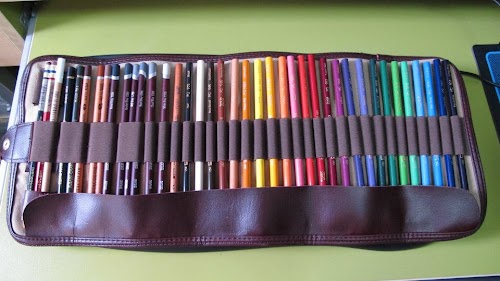
Qn: What are colour pencils are those? Seems like a mixture of two brands.
The solid-coloured ones are Prismacolor. I was given a set ages ago. The greys are Derwent Colorsoft. There are a couple of Col-Erase ones on the left, some Cretacolor ones, and a couple of Conte pencils. I've since added more Prismacolors to my collection and repacked my pencil wrap a bit.
Qn: What's the pencil wrap that you're using? Is it good at protecting the pencils?
It's a Derwent pencil wrap. It protects the pencils well. Once rolled up, the pencils provide support for one another. I don't find my leads breaking in the wrap.

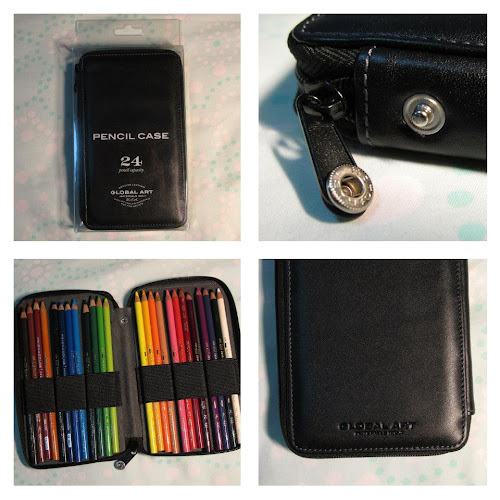
Qn: Are these the same colour pencils as above? What pencil case is that. Looks like leather?
Yes, these are from the same set above. I just got this Global Art Pencil Case today. It holds 24 pencils, but in a very tight fit. Reviews say the elastic bands are very tight. I wanted to see how the pencils fit so I took some of the Prismacolors and put it in. It can hold other kinds of pens and pencils. It is genuine leather but very affordable. Comes in canvas and different colours, and also different sizes holding 48, 72, and 120 pencils.

Qn: What's this bag used for?
This is a pen case made by Lihit Lab. I use it to hold a basic kit, especially for traveling. Currently it holds my mini travel watercolour box, 3 travel brushes, 3 Pentel waterbrushes, 5 Micron pens, a pencil, a white gel pen, 3 Hero fountain pens, an eraser, a plastic card, a small piece of sponge, and even a small box of 6 Koh-I-Noor watercolour pencils. I used to use a Smiggle case, but found this more compact.
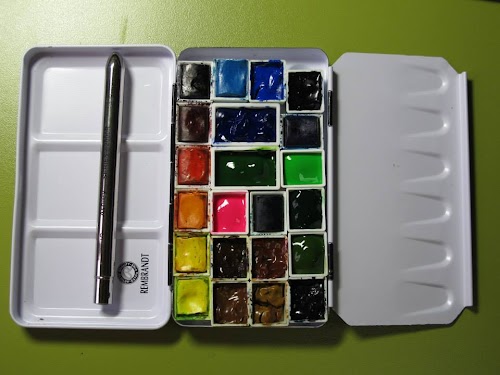
Qn: What watercolours do you use? Do you have any preference for specific brand?
I use Winsor and Newton, Holbein, Schmincke, and ShinHan. This is my mini travel set comprising of W&N half-pans, Holbeins and ShinHans (squeezed from tubes). I like the greens by ShinHan (a Korean brand). Holbein is an affordable option and pretty good. This set is chosen for transparency, so my Schmincke colours (which are mostly opaque) aren't represented here.
Qn: What watercolour box is that? It looks customised. Usually there's some sort of pan holder in the middle, right?
It is a Rembrandt box for 12 half-pans. I took out the holder so I could fit more pans in (stuck to the base with blu tack). It holds as many colours (actually a little more) as my 24 half-pan W&N set, but occupies less than half the space.
Qn: Do you prefer watercolour tubes or pans?
When I'm on the go, I tend to use pans because tubes can be messy. I'll squeeze the tubes into empty pans and let them dry for 2-3 days if I want the colours in my set. They are just more convenient that way. But if I'm painting larger pieces at home, I might opt for tubes.
Qn: What's that shiny thing beside the watercolour pans?
It's a bullet. I'm kidding. That is an Ashley 2000R travel brush. Size 5, red sable.
Qn: Do you use any other watercolour brushes?

Yes. I have a couple of Da Vinci kolinsky travel brushes, another size 12 Da Vinci Maestro, a size 16 Escoda Ultimo mixed-hair mop, and several smaller Raphaels and other random brushes.
Qn: What watercolour paper do you prefer?
I haven't tried many watercolor papers, but from those I've tried, my favourite is the one used in the etcetra sketchbook produced by Grandeluxe. It doesn't dry too quickly and allows you to play with your colours more. At the same time it doesn't dry too slowly either. Moleskine's is not bad too, but they are much more expensive.


Qn: What do you use these bottles for?
They are for holding water for painting. The Nutella one was given to me by my brother and sister-in-law (with the Nutella inside!). It holds the same amount of water as a film cartridge box, but is more stable. Its small size makes it easy to carry around for quick sketches. Fits nicely into my waist-pouch too! The pink one at the bottom is used when I need more water. It is collapsible, so it's quite compact to bring around.
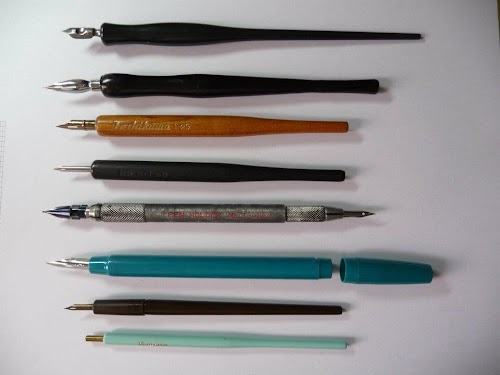
Qn: These look like dip pens. Can you give us a rundown on them and what you use them for? What's the difference? There are quite a lot of them.
I began using dip pens when I was doing more comic illustration. I did a comic book once using the Japanese G nib, but have since moved away from them as they laid down too much ink for my liking. I stick to the Hunt 102 and Hunt 107 nibs now, which are preferred by comic artists in the west. The 102 has good flex for line variation, but at the same time it has a fair amount of stiffness and gives me good control over my lines. The 107 has less flex and gives a more even line. I also use a Hunt 56 pretty often. It is a very flexible nib that gives a broader line than the 102.
Dip pen nibs are broadly classified into writing and drawing nibs. Drawing nibs tend to have a sharp tip while writing nibs may have sharp, flat, or even circular tips. Some specialty nibs may have several tips per nib - something resembling a comb - that allows you to write or draw parallel lines. There are even nibs made in other shapes like that of a hand, and even the Eiffel Tower! Those are mainly decorative.
Each nib has its own characteristic, such as stiffness and ability to hold ink. Some nibs come with a reservoir that increases the capacity before you have to recharge the pen (i.e. dip it in the ink bottle again). It takes some experimentation to find something that suits your drawing style. The shank of the nib that connects to the holder comes in about 3 or 4 standard shapes/sizes, so it's important to get the right holder for the nib you are using. Be sure to try your nibs on the holder before buying to make sure it fits.
Dip pen holders come in different shapes and sizes too. My favourite is the aluminium one in the middle that holds a nib at each end. Each end fits a nib with a different type of shank, and they can be unscrewed or tightened to attach the nibs. For calligraphy, some holders have an armature that hold the nib at an offset angle. They are called oblique holders and are used normally for writing rather than drawing. When choosing a holder, the most important thing is whether it can fit the nib you want to use it with. The next thing is whether it can hold the nib tightly. If the nib is too loose, it may slide into the holder when you apply pressure, or it may rotate while you are drawing, affecting your artwork. The third thing is ergonomics (and, of course, cost).
One more note about dip pen nibs is that they usually come with a thin layer of grease to prevent rusting. You need to get the grease off before using them or it will affect the flow. Some people rub it off with an eraser. I prefer to pass the nib quickly through a lighter flame and burn the grease off. It's quicker. But don't hold it in the flame too long or you might ruin the nib.
Qn: Do you use technical pens, if so, what do you use?
I don't use technical pens like the Rotring types. As a comic artist, I tend to like some line variation. If I want to draw with even lines, I usually use felt-tip Micron pens. I use mainly Sakura's Micron pens for the archival ink and darkness of the blacks. Not all blacks are equally black, especially when it comes to felt-tip pens.

Qn: What are the items in this set? What are they used for?
The leftmost pen is a Hero 578 curved-nib fountain pen. It is very versatile and allows me to draw thin as well as thick lines depending on the angle with which I'm holding the pen. I usually load it with Calli ink because it's waterproof and quite affordable. However, the ink can dry and affect the flow if the pen is not used in a while, but usually dipping the tip in some water would get it working again. That failing, it would be time to wash and flush the pen.
The next 2 are Pentel ink brushes. The grey one has a smaller tip size. The ink is waterproof (be warned: not every ink brush comes with waterproof ink!).
The 3 blue ones are Pentel waterbrushes of different sizes. The handle is a reservoir for water, so they can be used without having to carry a water container around. Just squeeze to wet the tip, and wipe it off to clean it.
The pouch on the right is the Accurasee Sketch Caddie. It is my favourite travel pencil case. It is about A5 size and has an elastic band that slips over an A5 portrait-format sketchbook (hard)cover easily. It is quite spacious and holds everything in the photo, and then some. On its front it has elastic bands to hold 3 pens/pencils. The ones in the photo are a mechanical pencil, a Pentel pocket brush, and a Pilot Parallel Pen (a flat-tipped calligraphy pen, but I use it mainly for drawing). It also has 2 front pouches for other small items like erasers, cartridges, sharpeners, etc.

Pilot Parallel Pen

ShinHan Touch markers
Qn: What are these markers that you use? They don't seem like Copic markers. How do they compare to Copic markers?
These are ShinHan Touch markers. Very similar to Copic, but cheaper. They are very comparable. The colours are vibrant. They are duo-tipped. I prefer those with one flat broad, and one brush tip on each side. They also have another type with a fine and a flat broad. Like Copic, these are alcohol based and may bleed through normal paper. They should be used in well-ventilated areas.
Qn: How do you choose the colours for these markers?
I buy the Touch markers individually and choose them based on the colours I'm most likely to use. Because markers tend to be expensive, I don't usually invest in the entire range. I also try to think what colours I can get if I layer them. I have a set of 6 greys (3 warm, 3 cool) which I sometimes use to layer over the other colours to darken them.
The Touch markers are also mixable using a colourless blender. You can mix several colours on a plastic sheet using the colourless blender and use the blender to apply the colour to your artwork. The blender can then be wiped off for the next use.
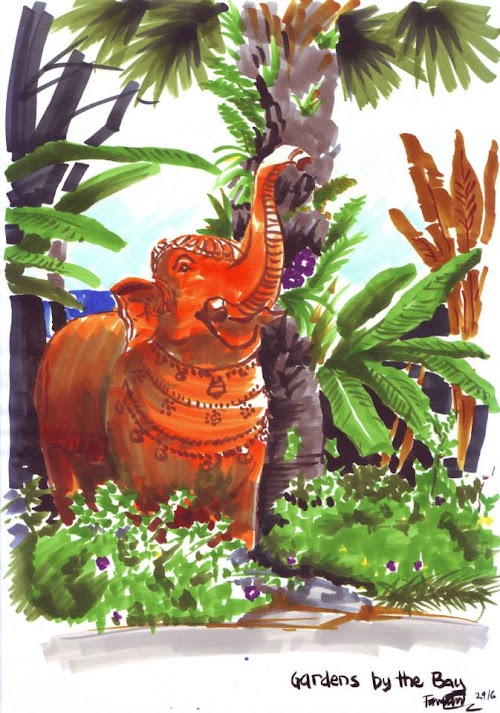
Coloured with Shinhan markers

Coloured with Shinhan watercolours
Qn: What paper do you use these markers on? Are there special considerations when using markers?
ShinHan produces their own marker paper which is surprisingly good. It is very thin and comes in a pad, but the markers don't bleed right through to the sheet underneath, even though you can see the colours on the underside. I don't know how they do it. Other than that, I just use them on any paper that takes markers without bleeding too much. If I'm afraid of them bleeding through to the sheet below, I just put a piece of card or scrap paper under the sheet I'm drawing on.
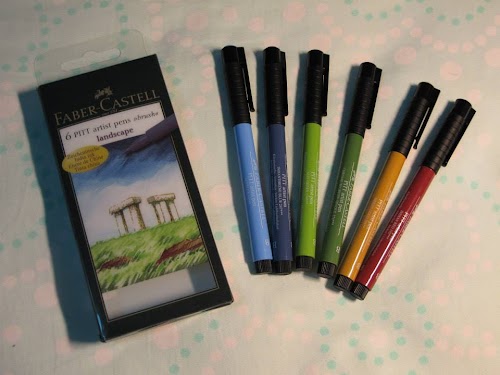
Faber Castell Pitt pens
Qn: What are these pens are and what do you use them for?
These are Faber Castell Pitt pens. These are the brush-tip variety (they also come in the normal felt-tip pen form). They come in sets (eg. greys, browns, landscape, basic colours, etc.) but may also be bought individually.
I have about 20 of them. Unlike normal markers like Touch and Copic, these are not alcohol-based and will not bleed through paper. They contain pigmented India ink. The colours are not as intense as my Touch markers, and they are not refillable either. However, they are compact and versatile and allow me to use them on normal sketchbooks without worrying about whether they are going to show through the underside of the page I'm colouring on.

Created with Pitt pens
Qn: What sketchbooks do you use?
I use a variety of sketchbooks, but tend to gravitate towards those with multi-media paper, such as Daler Rowney's Graduate and Simply series, Stillman and Birn Alpha and Gamma, and the Sketch2book, which is a handy portrait-cum-landscape sketchbook in one.
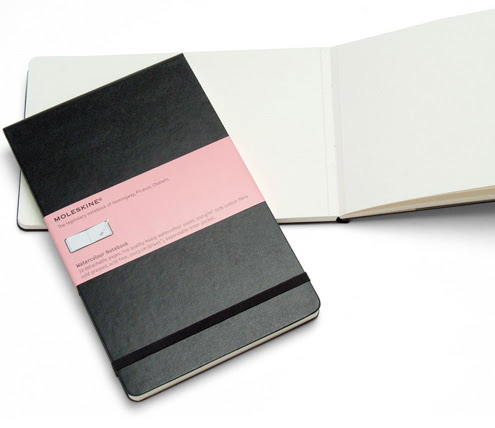
Moleskine watercolour sketchbook
I've used Moleskine's watercolour sketchbook as a travel sketchbook too, but that's for ink and watercolour, and not very suitable for colour pencils and markers, for which I prefer less textured paper with a bit of grain.
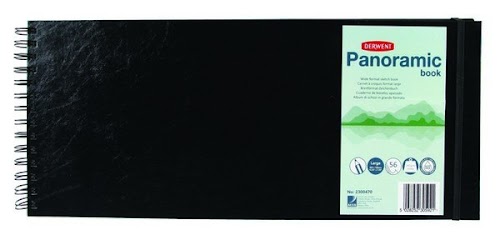
Recently I bought a Derwent panoramic sketchbook to do panoramic scenes. It has been quite fun!
Qn: You create artworks for games and videos right? What equipment do you use at work?
Actually I don't do artwork for games and videos in my current line of work, since the films we work on are all live-action. While I was in animation school, however, I specialised in concept art. Most of my artwork then was created digitally, or inked on paper then coloured in Photoshop. The exception was storyboards, for which I tended to use pencils or coloured pencils for the linework. For other illustrations, including my comics, I usually do my linework on paper using dip pens or sable brush and india ink on Japanese comic paper before scanning them and colouring them in Photoshop. Some of those illustrations can be found at https://www.zazzle.com/wensworld.

You can check out more of Favian's work at https://fav-art.blogspot.sg and https://sketchpacker.blogspot.sg/
Comments for Favian Ee?
If you have comments for him, send them here: https://sketchpacker.blogspot.sg/2013/12/im-featured-on-parka-blogs.html
Items mentioned may be available at Amazon.com and Amazon.co.uk


